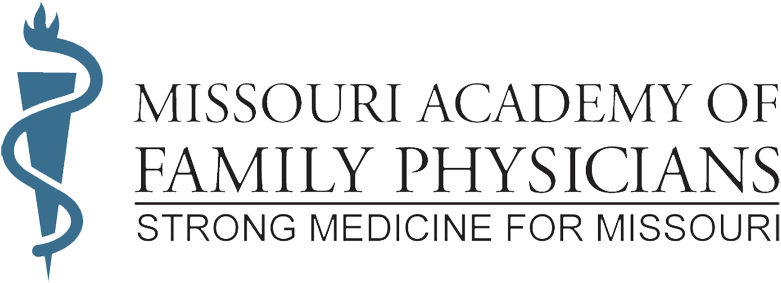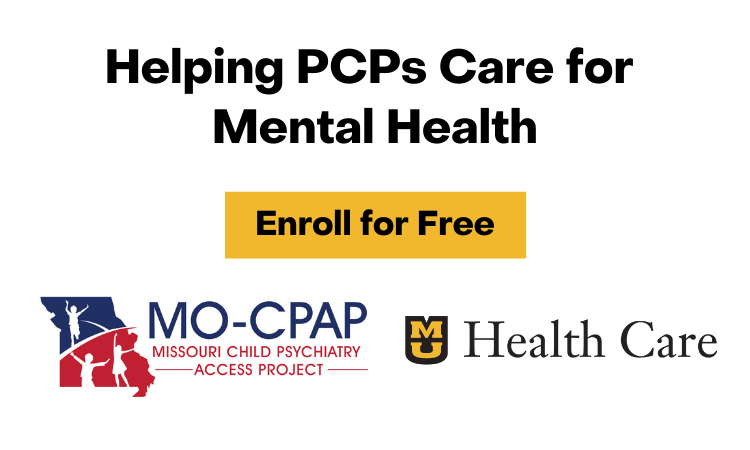My car and I were both messy as I visited Districts 8 and 9, it’s body thickly covered in the green pollen that settles upon Missouri in mid-April and my own clothing smeared with streaks of it as well. I was nonetheless welcomed by staff and physicians of three clinics across both districts. The day was rich in discussion, so much so that I took 10 pages of notes! This month’s blog is a bit longer as it covers two districts but I pared down my thoughts here to those I think most immediately interesting!
Dallas County Family Medical Center
I began in Buffalo, with Director Dr. Kurt Bravata, partner Dr. Kristina Kaufman, current medical student rotator Beza Getahun and colleague Dr. Ron Evans, himself a family physician and CMO of Citizens Memorial Hospital. We chatted over lunch, a break in what was obviously a busy clinic day.
I asked what their community is doing successfully that other family doctors might replicate. The group highlighted their “Make it Better” projects. Essentially, the health system identifies a local health equity issue then engages stakeholders in brainstorming and implementing solutions. It’s a classic quality improvement strategy like Lean or PDSA cycles but has intriguingly resulted in family physicians stepping up to say, “well, heck, I can take care of that” and then becoming THE local resource to do so.
For example, in a county that lacks comparable resources for substance recovery, Dr. Bravata took the lead in medication-assisted therapy for recovery. Dr. Evans noted that once that need and Dr. Bravata’s interest in it were matched, the hospital mindfully supported his ability to grow and thrive that clinical niche in his practice. Not only did a family physician become the local expert in MAT but he also found intense professional satisfaction in doing so, contributing to maintenance of his well-being. It is a win-win situation from which Dallas County and Citizens Memorial are beginning to apply lessons learned to other clinical niches for other family doctors, most notably in the areas of maternity care, nursing home care or hospital medicine. Beza, already interested in Family Medicine, was quick to point out those clinical passions in turn fuel the pipeline of family physicians as they spark interest in our specialty among medical students.
Amish Outreach Clinic
As I next neared the Amish Outreach Clinic in Seymour, I slowed for horse-drawn buggies and waved to girls dressed in bonnets as they played tag in roadside pastures. I parked next to a horse and entered the clinic space to meet Dr. Nancy Hayes and her staff. I wreaked havoc with Dr. Hayes’ busy schedule as I queried her about her history of service to Missouri’s Amish community and the operations of the clinic.
It became clear the clinic bridges a health care gap in Webster County. Dr. Hayes, retired from practice, donates her time so that the clinic can provide prenatal and medical care to the local Amish community. The clinic has enough resources to operate one day weekly and is in immediate need of volunteers or relationship with a residency program, medical school or other entity if it is to remain sustainable.
Some members may recall I wrote about free clinics in August. The Amish Outreach Clinic is not free. However, it occurs to me there are a host of resource-scarce clinics in our state that would benefit from networking opportunities. Dr. Hayes, for example, has a garage full of office equipment her clinic may never need that she might swap to another clinic for resources or volunteer hours in return. I ended up overstaying my time at the clinic to observe a prenatal visit. As I bid farewell to Dr. Hayes and her patients to hasten to my next visit, I began to wonder in what ways MAFP might support family doctors in medical volunteerism or community outreach.
Texas County Memorial Hospital Complex
Director Dr. Tricia Benoist graciously waved away my apology for my tardiness. I met her at the end of a long day in her own clinic on the TCMH complex, joined by her partner Dr. Matt Brown and colleague Dr. Doug Crase, a family doctor in nearby Licking.
The group started by asking for the moon. 😊 In other words, they requested expansion of Medicaid eligibility in Missouri and implementation of a state-wide prescription drug monitoring program, both of which are lofty legislative goals that MAFP will continue to support.
We didn’t immediately turn to more attainable goals, either, as they echoed some familiar frustrations. For example, Dr. Brown noted their clinic had to hire a full-time staff just to work referrals. As in many clinics, resources that could be dedicated to social work, patient education or population health must instead be dedicated to cumbersome paperwork thrust (often unnecessarily, I would argue) upon us by health insurers. Dr. Brown noted that few things fulfill him more as a family doctor than being called in from home at 3AM to perform an intubation or other emergent procedure for a patient while few things frustrate him faster than being in the office at 1PM just to fill out more forms.
By the middle of our conversation, however, I perceived that, despite their complaints about our larger health care system, this group just seemed happy and energetic. They didn’t act like physicians who were burned out. I am beginning to notice in my visits that the happiest family doctors seem to be the ones who a) practice wider scopes of clinical care and b) practice in locations or health systems where physicians, particularly family physicians, are actively engaged in leadership and administration. And so, on a hunch, I asked what leadership roles they carried. Sure enough, both Drs. Benoist and Brown are on the medical staff council of their hospital, meaning half of the hospital physician leadership are family physicians.
Dr. Benoist even demonstrated her leadership initiative by closing our meeting with a list of topics she thought would be best for future MAFP CME conferences. (They’re some good ideas, guys, so I’ll see what I can do!)
I am beyond words in my appreciation to Drs. Benoist, Bravata, Brown, Crase, Evans, Hayes and Kaufman and to future doctor Getahun for their enthusiasm, time, insights and suggestions, including those for which this small blog had not enough space. I am beginning to recognize some common themes from my district visits that I hope will offer excellent guidance to MAFP and it’s membership on behalf of the patients we all serve. I look forward to summarizing my observations for both the board of directors and the membership at large this summer.
As always, any misspeaks, misquotes or other mistakes are solely my own, as are any opinions expressed, and reflect upon neither the Missouri or American Academy of Family Physicians nor their respective staffs.



